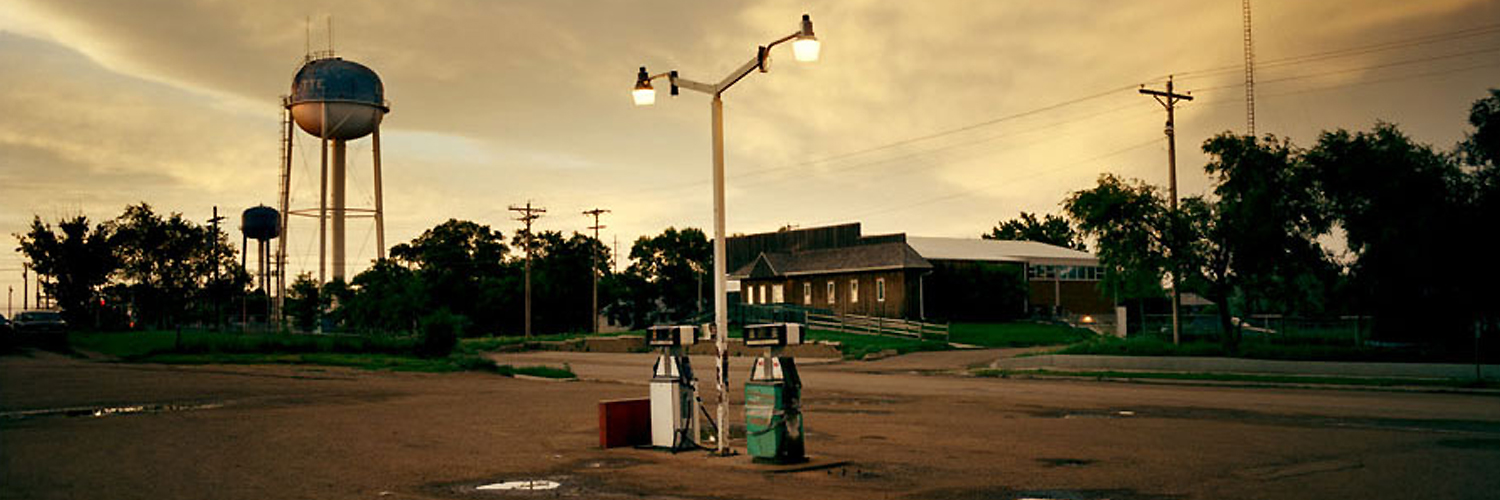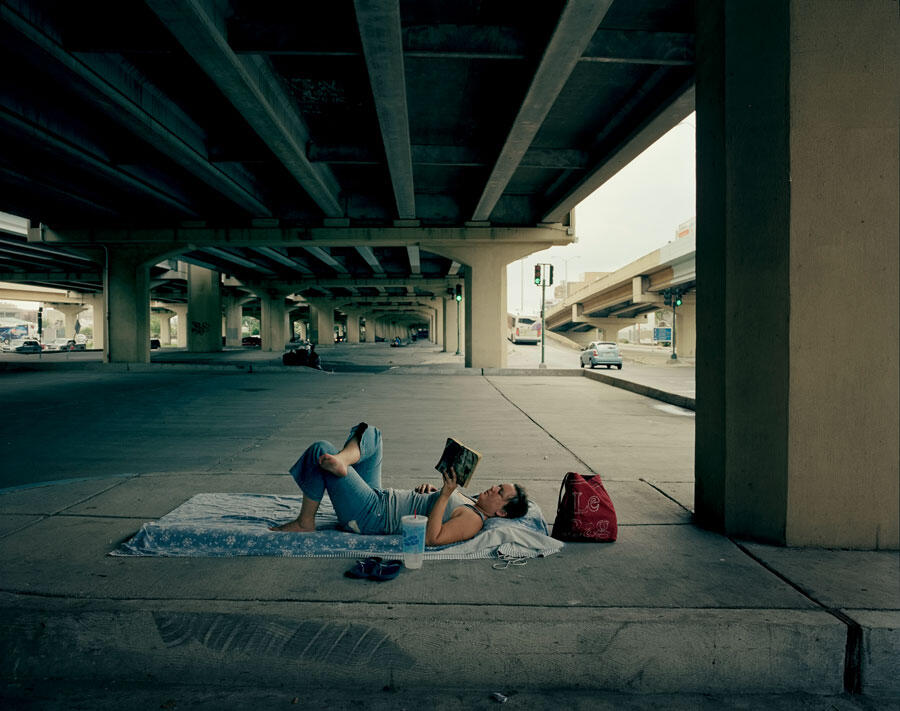A photo essay by Joakim Eskildsen
Fresno
Often called the breadbasket of the country, much of the nation's fruits and vegetables come from the Central Valley of California, where Fresno is located. Peaches, plums, grapes, cotton, almonds, tomatoes, cattle, and milk are among the region's products. But the wealth of the agriculture industry hasn't trickled down evenly in this abundant and fertile place; Fresno has one of the highest poverty rates in the country. Driving through Fresno, I was struck by the sprawling tent cities on the outskirts of town, where many of the city's more privileged residents rarely go. "It's a tale of two cities, the upper class lives in the north, and the poor in the south," said the director of a food bank. From migrant workers and small farmers to blue- and white-collar workers, who had been chewed up and spit out by the economic recession, the economic hardship this area faces runs deep. Though many people here struggle to buy the food that they need, the area is still plagued by an obesity problem. But the biggest problem is simply a lack of good jobs. To make matters worse, California's state budget plan has deep cuts to welfare and other social services, weakening the already fragile social safety net.

South Dakota
The socioeconomic problems on the Native American reservations date back to when the reservations were created and are directly tied to land ownership. Few Native Americans own land as much of it is held in US trust. Because reservations are governed by their own set of rules, obtaining business contracts under tribal law is difficult and underdeveloped legal structures and codes minimize incentives for outside businesses and investors. Likewise, tribal leaders mistrust outside investors. Reservations are far from major cities, making it hard for residents to get stable jobs and educational opportunities outside the reservation.

Athens
In many ways, Athens, Georgia, is a charming town with classic and Antebellum architecture, a restored downtown full of shops and restaurants, a vibrant independent music scene, and the University of Georgia, the oldest and largest college in the state. But life for most of its residents is a struggle. Athens-Clark County has a poverty rate of 40 percent, the highest in counties with a population of more than 100,000 across the United States, according to the 2011 American Community Survey. Homelessness is on the rise with local shelters at full capacity. Kerri Steele from the Athens Area Homeless Shelter said that she is getting more calls from people with college degrees and there is a wait-list to get into the shelter. "A lot of people aren't even trying to get a space in the shelter anymore," she said. Athens has many low-skilled, low-income workers, and no black middle class. Though the University of Georgia provides a large portion of the jobs in the county, many of those, once staffed by locals, are now being staffed by students. Quenton Scott, a 27-year-old local, said people from Athens either leave, stay and take a minimum wage job, or they are in the streets and in and out of jail. "There is no big business in Athens," he said, "no big opportunities."


South Bronx
A walk through the South Bronx reveals the one of nation's most ethnically diverse neighborhood. Latin music and hip hop blast from car radios, streets are lined with Hispanic bakeries and bodegas, buildings are sprayed with colorful graffiti, and Spanish is spoken on every corner. Gritty and lively, the South Bronx is also among the poorest congressional districts in the country with a significant number of adults and children living below the poverty level. Single females run half of the families here. Since the economic recession hit in 2007, unemployment has become a persistent problem. Contributing to its difficulties is the Cross-Bronx Expressway, which cuts through residential neighborhoods, causing property values to drop and remain low. By the late 1960s, the South Bronx became synonymous with crime, poverty, and arson. To offset losses in property value, landlords started setting fire to their buildings to collect insurance money. The vacant lots and derelict buildings only worsened the situation, attracting gangs, drug addicts, and squatters. While the area has seen resurgence since the 1970s thanks to affordable housing, new building construction, and an increase in population, it still faces extreme poverty, crime, and hunger. According to the City Harvest Program, more than 292,000 people are not getting the right food for an active, healthy lifestyle, and the South Bronx also has one of the highest obesity rates in the nation.

New Orleans and Plaquemines Parish, Louisiana
New Orleans is considered one of the most unique cities in the United States, with colorful French colonial architecture, musical heritage and festivals, Creole food, and historical mix of African American, Native American, and European cultures. However, this Southern city of color and revelry is also a place where income and opportunities are divided along racial lines, part of the legacy of segregation, and has the highest per capita murder rate in the country. Poverty and violence are concentrated in poor black neighborhoods, such as the Ninth Ward, that were also the hardest hit during Hurricane Katrina. As the city struggled to rebuild and get back on its feet, the recession and the BP oil spill in 2010 took an economic and environmental toll on the recovery process. The people of New Orleans have faced many challenges and made much-needed improvements since the storm and oil spill, building new charter schools, improving access to low-income health care, and reforming the criminal justice system. Much of the city has bounced back, but old black neighborhoods still have many vacant lots and homes. The local economy is still feeling the effect of lost jobs, and the need for affordable housing remains high on the list of priorities.
Plaquemines Parish, a thin stretch that follows the Mississippi River and juts into the Gulf of Mexico, is surrounded by water. For generations, fishing and farming have been a way of life for the rural communities of the region. Located 12 miles south of New Orleans, the region is frequently struck by storms and the residents who have settled here have developed a reputation for resilience and recovery. A series of recent disasters, however, have left the community reeling and wondering whether it is worth trying to rebuild once again. In 2005, the parish suffered catastrophic damage in Hurricane Katrina, with a storm surge of more than 20 feet and the subsequent failure of the levees. The area's seafood industry took a major hit and a large portion of the population was displaced. During the BP oil spill in 2010, roughly 200 million gallons of oil were leaked into the Gulf, causing damage to the area to an unseen extent. More recently, Hurricane Isaac wreaked havoc in the parish, washing up tar balls from the oil spill on the shores of Louisiana's Gulf Coast.



This web site features photographs by Joakim Eskildsen, donated to the Urban Institute for the purposes of this project. The images are meant to highlight the current state of deep and persistent poverty within the United States. The Urban Institute would like to thank Mr. Eskildsen for his generosity.